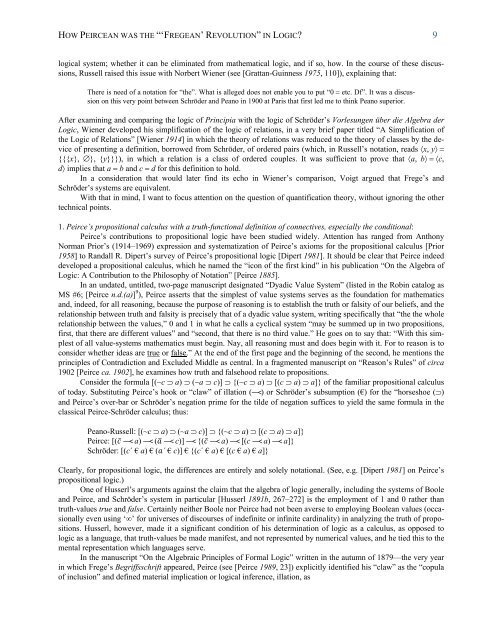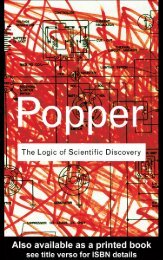Create successful ePaper yourself
Turn your PDF publications into a flip-book with our unique Google optimized e-Paper software.
HOW PEIRCEAN WAS THE “‘FREGEAN’ REVOLUTION” IN LOGIC? 9<br />
logical system; whether it can be eliminated from mathematical logic, and if so, how. In the course of these discussions,<br />
Russell raised this issue with Norbert Wiener (see [Grattan-Guinness 1975, 110]), explaining that:<br />
There is need of a notation for “the”. What is alleged does not enable you to put “��� etc. Df”. It was a discussion<br />
on this very point between Schröder and Peano in 1900 at Paris that first led me to think Peano superior.<br />
After examining and comparing the logic of Principia with the logic of Schröder’s Vorlesungen über die Algebra der<br />
Logic, Wiener developed his simplification of the logic of relations, in a very brief paper titled “A Simplification of<br />
the Logic of Relations” [Wiener 1914] in which the theory of relations was reduced to the theory of classes by the device<br />
of presenting a definition, borrowed from Schröder, of ordered pairs (which, in Russell’s notation, reads �x, y���<br />
{{{x}, �}, {y}}}), in which a relation is a class of ordered couples. It was sufficient to prove that �a, b�����c,<br />
d��implies that a � b and c � d for this definition to hold.<br />
In a consideration that would later find its echo in Wiener’s comparison, Voigt argued that Frege’s and<br />
Schröder’s systems are equivalent.<br />
With that in mind, I want to focus attention on the question of quantification theory, without ignoring the other<br />
technical points.<br />
1. Peirce’s propositional calculus with a truth-functional definition of connectives, especially the conditional:<br />
Peirce’s contributions to propositional logic have been studied widely. Attention has ranged from Anthony<br />
Norman Prior’s (1914–1969) expression and systematization of Peirce’s axioms for the propositional calculus [Prior<br />
1958] to Randall R. Dipert’s survey of Peirce’s propositional logic [Dipert 1981]. It should be clear that Peirce indeed<br />
developed a propositional calculus, which he named the “icon of the first kind” in his publication “On the Algebra of<br />
Logic: A Contribution to the Philosophy of Notation” [Peirce 1885].<br />
In an undated, untitled, two-page manuscript designated “Dyadic Value System” (listed in the Robin catalog as<br />
MS #6; [Peirce n.d.(a)] 9 ), Peirce asserts that the simplest of value systems serves as the foundation for mathematics<br />
and, indeed, for all reasoning, because the purpose of reasoning is to establish the truth or falsity of our beliefs, and the<br />
relationship between truth and falsity is precisely that of a dyadic value system, writing specifically that “the the whole<br />
relationship between the values,” 0 and 1 in what he calls a cyclical system “may be summed up in two propositions,<br />
first, that there are different values” and “second, that there is no third value.” He goes on to say that: “With this simplest<br />
of all value-systems mathematics must begin. Nay, all reasoning must and does begin with it. For to reason is to<br />
consider whether ideas are true or false.” At the end of the first page and the beginning of the second, he mentions the<br />
principles of Contradiction and Excluded Middle as central. In a fragmented manuscript on “Reason’s Rules” of circa<br />
1902 [Peirce ca. 1902], he examines how truth and falsehood relate to propositions.<br />
Consider the formula [(~c � a) � (~a � c)] � {(~c � a) � [(c � a) � a]} of the familiar propositional calculus<br />
of today. Substituting Peirce’s hook or “claw” of illation (―





